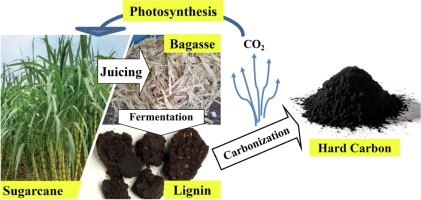Journal of Cleaner Production ( IF 9.7 ) Pub Date : 2019-02-12 , DOI: 10.1016/j.jclepro.2019.02.114 Mohannad Mayyas , Rasoul Khayyam Nekouei , Veena Sahajwalla

|
The heavy use of coal-derived coke (CDC) in steel industry makes it a major contributor to the greenhouse emissions. With the impact of global warming knocking our doors, the CDC has experienced supply shortages and increasing costs. Such scenario has raised the need to find a sustainable and renewable replacement to CDC. Hard-wood biomass has emerged as a promising alternative to the CDC. While such sources of virgin biomass remain at high cost, other types of agro-industrial residues constitute an opportunity for further sustainable utilization. In the current work, we have assessed the suitability of an abundant source of biomass waste, i.e., lignin-rich press mud (LPM), for steel industry. Hard carbons were obtained from LPM through a thermal treatment at a wide range of temperatures, and the chemical content (i.e., impurity) of all carbons was compatible with the steel making process. Before fitting the LPM-derived carbons (LPMCs) for such purpose, several carbon properties (e.g., chemical content and reactivity) and carbon-steel interactions (e.g., iron oxide/slag reduction, steel carburizing) were comprehensively studied and evaluated. The LPMC obtained at high temperature has particularly demonstrated an excellent reduction performance and desirable slag interactions compared to a typical metallurgical coke. The diffusion of S from LPMC into steel was an issue raised and discussed in this study. The reduction of S in LPMC was demonstrated and a subsequent enhanced C uptake in steel of 2.38% was achieved.
中文翻译:

钢铁行业中木质素生物质作为碳原料的价值评估:氧化铁还原,钢渗碳和炉渣发泡
钢铁行业大量使用煤炭衍生的焦炭(CDC),这使其成为温室气体排放的主要贡献者。由于全球变暖的影响敲响了警钟,CDC经历了供应短缺和成本上升的情况。这种情况提出了寻找CDC的可持续和可再生替代品的需求。硬木生物质已成为CDC的有前途的替代品。尽管这些原始生物质资源的成本仍然很高,但其他类型的农业工业残留物却构成了进一步可持续利用的机会。在当前的工作中,我们评估了丰富的生物质废物源(即富含木质素的压榨泥浆(LPM))对钢铁行业的适用性。通过在很宽的温度范围内进行热处理以及化学成分(即,杂质)与炼钢工艺兼容。在为此目的安装LPM衍生碳(LPMC)之前,应全面研究和评估几种碳特性(例如化学含量和反应性)和碳钢相互作用(例如氧化铁/炉渣还原,钢渗碳)。与典型的冶金焦相比,在高温下获得的LPMC特别表现出优异的还原性能和所需的炉渣相互作用。本研究提出并讨论了S从LPMC扩散到钢中的问题。证明了LPMC中S的减少,并且随后提高了2.38%的钢中C吸收率。化学含量和反应性)以及碳钢相互作用(例如,氧化铁/炉渣还原,钢渗碳)得到了全面的研究和评估。与典型的冶金焦相比,在高温下获得的LPMC特别表现出优异的还原性能和所需的炉渣相互作用。本研究提出并讨论了S从LPMC扩散到钢中的问题。证明了LPMC中S的减少,并且随后提高了2.38%的钢中C吸收率。化学含量和反应性)以及碳钢相互作用(例如,氧化铁/炉渣还原,钢渗碳)得到了全面的研究和评估。与典型的冶金焦相比,在高温下获得的LPMC特别表现出优异的还原性能和所需的炉渣相互作用。本研究提出并讨论了S从LPMC扩散到钢中的问题。证明了LPMC中S的减少,并且随后提高了2.38%的钢中C吸收率。本研究提出并讨论了S从LPMC扩散到钢中的问题。证明了LPMC中S的减少,并且随后提高了2.38%的钢中C吸收率。本研究提出并讨论了S从LPMC扩散到钢中的问题。证明了LPMC中S的减少,并且随后提高了2.38%的钢中C吸收率。











































 京公网安备 11010802027423号
京公网安备 11010802027423号